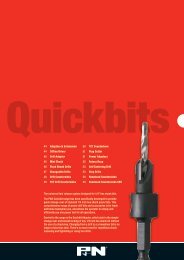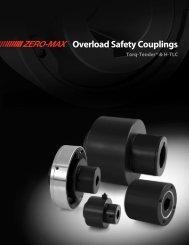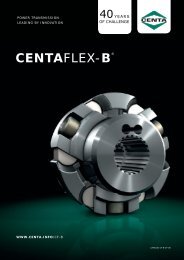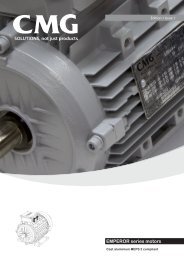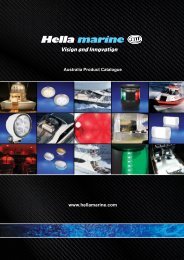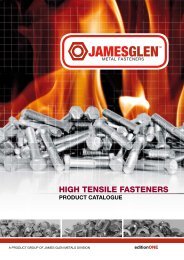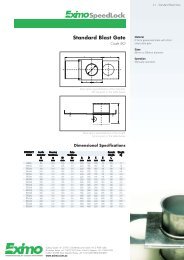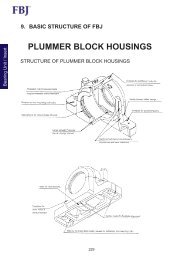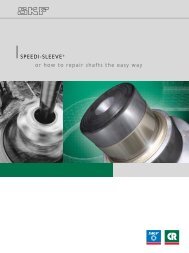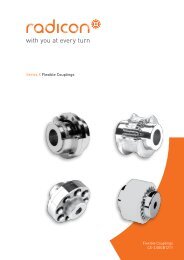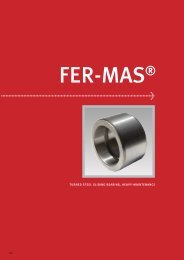Create successful ePaper yourself
Turn your PDF publications into a flip-book with our unique Google optimized e-Paper software.
Section1One-way Clutch1-2 Operating mechanismClutch engagedWhen the outer ring tries to turn clockwise with respect to the shaft,the spring is activated and the rollers advance to the engagementposition of the outer ring cam surface, then the wedge actionbetween the outer ring cam surface and shaft drives the shaft.Clutch idleWhen the outer ring turns counterclockwise with respect to theshaft, the shaft turns clockwise with respect to the outer ring, sothat the rollers are released from the outer ring cam surface andthe outer ring is disengaged from the shaft.1-3 Types and construction<strong>NTN</strong> one-way clutchesOne-way clutchesOne-way clutch unitsHF typePartially INA productsHFL typeINA productsNHF typeNCM typeNCU type NCZ type NCZC typeNCZX typeNCUX type<strong>NTN</strong><strong>NTN</strong>4
Section1One-way ClutchShaft and housing (HFtype, HFLtype, NHFtype) / external resin parts (NCUtype, NCZtype, NCZCtype, NCZXtype, NCUXtype) specificationsShaftTypeMaterialDimensionsToleranceCylindricalityOne-way clutchOne-way clutch unitHFtype HFLtype NHFtype NCUtype NCZtypeNCZCtype NCZXtypeNCUXtypeTempered steel, case hardened steel(Hardness HRC58–64; effective depth 0.4 mm or greater for carburizing)h5h6One-half of toleranceh7One-half of toleranceCarbon steel, stainless steel, tempered steel, case hardened steel(Surface hardness if tempered: HRC50 or greater)NCU4h9NCU10h10NCZ68 h9NCZC68One-half of toleranceNCZX68h9NCUX4h8Roughness0.2aRa0.4aRa0.31.6aRaHousing (HFHFLNHF type)External resin part(NCUNCUXNCZNCZCNCZX type)MaterialBoreToleranceCylindricalityRoughnessWallthicknessRemarksSteel N6N7light metal alloysR6R7One-half of tolerance1.6aSteel, light metal alloysSteel: 0.75 (DF) or greaterLight metal alloy: 1.5 (DF) or greater(See the dimensions table for the DF dimension)One-half of tolerance1.6aStandard: Polyacetal resin(They can also be made of oil-impregnated polyacetal resin and PBT resin.)Gear accuracy: Grade 6 is the standard for JGMAengagement accuracy.Remark 1) Round off the tip of the shaft to facilitate insertion into the one-way clutch. (Minimum 0.3 mm)2) The requirements for the shaft and housing for the NCM type one-way clutch can vary depending on the operating conditions.Contact <strong>NTN</strong> Engineering for technical assistance.6
Section1One-way ClutchHFtype radial load bearingSelect by referring to the bearings in the table below.C1 C C1l C lDFwDd<strong>NTN</strong> shell-type needle roller bearing (HK type)<strong>NTN</strong> BEARPHITE oil-impregnated bearingShaftdiametermmOne-wayclutch numberBearing number<strong>NTN</strong> shell-shaped needle roller bearing (HK type)DimensionsmmFwBasic rated load NkgfD C1 Cr Cor<strong>NTN</strong> BEARPHITEoil-impregnated bearingBearing numberDimensionsmmdDlq<strong>NTN</strong> shell-shaped needle roller bearings include the closed endtype (BK type) in addition to the open end type (HK type) listedabove.In addition, there are HK and BK types with seals (single seal ordouble seal).Refer to the special catalog Needle Roller Bearings for thefeatures and assembly guidelines for shell-type needle rollerbearings.w<strong>NTN</strong> BEARPHITE oil-impregnated bearings are designed for anideal radial clearance with the housing and shaft tolerancesrecommended on page 6.If the width l of the <strong>NTN</strong> BEARPHITE oil-impregnated bearing is aproblem due to the available space, please consult with <strong>NTN</strong>.Refer to the special catalog <strong>NTN</strong> BEARPHITE Oil-impregnatedBearingsfor the features, loads, rotational speeds and installationdimensions of oil-impregnated bearing.9
Section1One-way Clutch1-8 Product applications1-8-1 One-way clutch for fishing reels[Explanation]Double-ender fishing reels incorporate an anti-reverse mechanism for their handle.To satisfy the needs from high-end anglers, this type of anti-reverse mechanisms has beenincreasingly incorporating a roller-type one-way clutch so that each angler can enjoy thedelicate feeling of the reel and promptly respond to a quick bite by fish. To be able to improvethe feeling with the reel, the <strong>NTN</strong> one-way clutch boasts achievement of higher balancebetween two conflicting basic requirementsreliable locking function and lower idling torque.The <strong>NTN</strong> one-way clutch for this purpose features reliable corrosion-resistance since itcomprises stainless steel components and plated parts.[Features of one-way clutch for finishing reel]1. Excellent rust-resistance qualityFishing reels are often stored without removing seawater on them. As a result, rust can quickly occur on them, leading to amalfunctioning clutch.With the <strong>NTN</strong> one-way clutches for fishing reel, their outer ring is plated, the rollers and springs are made of stainless steel and thecage is composed of a resin. Thus, they offer excellent rust-resistance quality, and maintain reliable clutch function even under verysevere operating conditions such as an environment filled with saltwater mist.2. Reliable clutch functionThe <strong>NTN</strong> one-way clutch for fishing reel employs a stainless steel spring. This feature allows the one-way clutch to be reliably lockedeven in a cold climate (no problem has occurred at -20C: bench test by <strong>NTN</strong>, see *1).3. Low idling torqueUse of a specially shaped spring ensures a low idling torque (approx. 50% compared with conventional one-way clutch). This featureleads to realization of higher balance between two conflicting basic requirementsreliable locking function and lower idling torque.4. Compact size & high load-carrying capacityBecause being held by the hand of angler for a prolonged time, a fishing reel has to be very light and compact. So that a compactfishing reel, when locked, can maintain a sufficiently great torque capacity, it needs to employ a highly rigid one-way clutch.The outer ring of the <strong>NTN</strong> one-way clutch for fishing reel is manufactured through a drawing process rather than a conventional pressprocess, and, therefore, the one-way clutch boasts a compact construction and higher rigidity.5. Easy assemblyThe outer circumference of the outer ring can be formed into a special shape. Then, by simply inserting the one-way clutch into thehousing whose inner surface conforms to the outer surface of the outer ring, the one-way clutch is fixed into position to preventundesirable rotation.14
Section1One-way Clutch[Example of fishing reel construction]Double-ender type with one-way clutchOne-way clutchSliding bearingHousingBall bearingBall bearing[Experimental data] *1 Comparison in locking performance under simulated cold climate (-20˚C)Insufficient locking (slipping)Employing a stainless steel spring rather than a resin spring, the<strong>NTN</strong> one-way clutch excels in locking performance, in particular,under a low-temperature condition.One-way clutch with resin spring<strong>NTN</strong> one-way clutchNumber of cycles Cycles[Dimensions table for <strong>NTN</strong> one-way clutches]BCDdProduct nameHFX10X17.1X8-2/0G2.510 -3 max.Dimensionsd D C B10 17.1 16 8 TorquecapacityNm3.0Idling *2torqueNmHFX10X17.1X12/0G1017.116125.32.510 -3 max.*2 The idling torque values are obtained from use of the <strong>NTN</strong> recommended shaft diameter9.9550.005.15
Section1One-way Clutch1-8-2 Personal computer and LCD panel (for hinge)DisplayRadial bearingsLocking directionOne-way clutchTorque limiterTypical application of one-wayclutch (hinge)Detailed view of one-wayclutch application[Operation of one-way clutch]¡In a normal operating condition, the one-way clutch remains in the locked mode and the weight of the display is stablysupported.¡When intending to swing down the display, the user will exert a torque (force) greater than the allowable torque on thetorque limiter (though the clutch remains locked), and, as a result, the torque limiter will slip, causing the display to lower.¡When the user attempts to swing up the display, the clutch will idle, allowing the user to smoothly swing up the displaywith a very light force.1-8-3 Clothes dryer (drum rotation mechanism)DrumMotor fordriving drumand fanOne-way clutchBall bearingAppearance of typicalclothes dryer Cross-sectional view Detailed view of one-way clutch applicationThe one-way clutch is built into the pulley for drum drive belt.[Operation of one-way clutch]¡When the drum and fan are running: the clutch is locked to drive the drum.¡When the fan alone is running (the drum is at a standstill): the clutch idlesand does not transmit power to the drum.16
Section1One-way Clutch1-8-4 Industrial sewing machine (cloth feeding section)On industrial sewing machines, an <strong>NTN</strong>one-way clutch is incorporated into aroller that intermittently feeds a piece ofcloth, being timed with the upward /downward motion of the needle.LinkSwing motionOne-way clutch (HFL type)UpperrollerNeedleClothLower rollerDetailed view of one-wayclutch application[Operation of one-way clutch]¡The clutch shaft swings via the link. The installed clutch is oriented such that when the clutch shaft is turned clockwise,the clutch is locked; when the shaft is turned counterclockwise, the clutch idles.¡When the shaft is turned clockwise, the clutch is locked, and the upper roller rotates in conjunction with the shaft,thereby the cloth is fed along the arrow direction.¡When the shaft is turned counterclockwise, the clutch idles, and the upper roller remains at a standstill. As a result, thecloth is not fed.¡The shaft repeatedly swings and the above-mentioned cycled is repeated, thereby the cloth is fed intermittently.1-8-5 Power-assisted bicycle (drive unit)One-way clutchRadial bearingSection incorporating one-way clutchThe driving power from the motor is transmitted to the chain via theone-way clutch. As a result, the rider’s power required for thepedals is reduced.[Operation of one-way clutch]¡When the motor is running (assist function is ON):The rotary output from the motor acts on the one-way clutch viathe reduction gearing, causing the clutch to engage. As a resultof this engagement, the drive force is transmitted from the clutchshaft, the sprocket and then to the chain.¡When the motor is not running (assist function is OFF):The clutch, which drives the chain, remains disengaged, whilethe clutch shaft receives the driving force from the chain.MotorsideDetailed view of one-way clutch application17
Section1One-way Clutch1-8-6 Clutch incorporated pulley (CIP)[Product overview]The pulley of an auxiliary device of a greater rotating inertia may incorporatea one-way clutch to mitigate the variation in belt tension and/or suppress thebelt slip noise. This type of pulley is known as "clutch incorporated pulley".¡Longer life for drive belt¡Prevention of vibration on drive belt¡Suppression of belt slip noiseReduction of belt tension variation[Features]¡Benefits with sprag-type one-way clutchCompact designGreater torque capacity¡Benefits with a construction comprising two rows of deep groove ballbearingsIncreased radial load capacityIncreased moment load capacity Joint development work incooperation with Bando ChemicalIndustries, Ltd.[Construction]SpragSpring Cover Cage Outer ring Pulley BearingShaftShaft speed < outer ring speedThe shaft remains engagedwith the outer ring.ThreadA range from15 to 24 mmis possible.min. 58Hex holeShaft speed > outer ring speedThe shaft slips relative to theouter ring.min.3918
Section1One-way Clutch[Operating principle]If an engine with greater speed variation drives a mechanism of a greater rotary inertia (alternator, etc.), greater tension variation occurson the drive belt, possibly rendering the service life of the drive belt shorter.To address this problem, <strong>NTN</strong> has attempted to incorporate a one-way clutch into a pulley to absorb speed variation and reduce belttension variation in order to achieve a longer belt life.(Bando Chemical Industries, Ltd.: Japanese Patent No. 216602, No. 2779331)V1V2V3V1Engine speedV2Pulley speedV3Alternator shaft speedIdlingLockedSpeed (rpm)V1Speed (rpm)V3V2When the engine speed is low owing tospeed variation, the alternator (whoserotary inertia is greater) tends to maintainits speed (V3).When V2 < V3, the clutch idles and, as aresult, absorbs the variation in rotaryspeed and mitigates the belt tensionvariation.[Recommended applications]¡Automotive auxiliary devices (alternator, etc.)¡Idling stop mechanism[Engineering data]PulleyAlternator shaftAlternator shaftSpeedSpeedPulleyTensionTensionUse of fixed pulley (no clutch)Use of clutch incorporated pulley19
Section2Two-way Clutch2-1 FeaturesIn contrast to one-way clutches which can drive in one direction only, any two-way clutch is capable of switchover between drive and idlemodes in both directions.For a situation where the user wants to transmit a torque in both forward and reverse directions, a two-way clutch may be employed.Consequently, use of a combination of complicated switching mechanisms is no longer necessary; and this advantage leads to simplificationand compact size of a transmission mechanism, as well as to a lower cost.2-2 Operating mechanismThe <strong>NTN</strong> two-way clutch comprises, as illustrated below, a regular polygon cam that is capable of driving in both directions, wherein eachcam face aligns with a roller. By switching the phase of the cage relative to the phase of the cam face, the clutch can be arbitrarily switchedto the neutral-idling state, forward-driving state and reverse-driving state.2-3 Provision of multiple functions with a variety of switchover schemesThe <strong>NTN</strong> two-way clutch line of products address specific needs of customer, and the examples include a roller two-way clutch (frictionswitchover type) with which the driving direction is automatically selected to cope with the running direction of the input shaft; and amechanical clutch unit (MCU) with which the operating mode is electrically selected from an external controller.Outer ringRollerCamCageDrivingIdlingDriving20
Section22-4 Applications2-4-1 Roller two-way clutch (friction switchover type)[Explanation]The operating direction of this type of clutch is automatically selected based on therotating direction on the input side.[Features]1Lower idling torque2Greater torque capacity and compact size3Pure-mechanical switchover system that does not need a special control device[Construction]Z-ZYOutput outer ringRollerZY-YSwitching plateCageWavy springInput shaftYCageSwitching plateZ[Operating principle]1One end of the switching plate is fixed to the static system while the switching plate is held to the cage by the force of wavy spring. As aresult, a resistance opposite to the rotating direction of the input shaft is exerted to the cage.2When revolution is transmitted to the input shaft, there will occur a speed difference between the input shaft and cage.3Consequently, within the two-way clutch, the rollers come into contact with the input shaft and output outer ring by the force of the leafsprings installed in the cage pockets, thereby the two-way clutch is ready for driving operation.4When the input shaft speed Ni>output outer ring speed No, the rollers are forced into the wedge-shaped spaces formed between the inputshaft and the output outer ring, allowing the torque from the input shaft to be transmitted to the output outer ring. (See Fig. 1.)5When the input shaft speed Ni
Section2Two-way Clutch2-4-2 Mechanical clutch unit (MCU)[Explanation]The <strong>NTN</strong> mechanical clutch unit consists of a mechanical roller clutch and anelectromagnet clutch to realize both greater transmission torque capacity and easycontrol.[Features]1Lower idling torque2Greater torque capacity and compact size3Excellent response owing to electrical control4No slippage transmitting torque: longer life5Simple construction that incorporates both roller 2WC and electromagnetic clutch[Construction]Electromagnetic clutchSwitchover between driving andidling (current ON/OFF control)ZArmatureRollerOutput outer ringRoller clutchTransmission of drive torqueCageZRotorCoilInput shaft (cam)Section Z-ZSwitch spring[Engineering data]The response speed varies somewhat depending on theoperating temperature. However, the response timealways remains not greater than 100 ms, which meansexcellent response speed1) (see the chart in the right:under oil lubrication).NOTE 1) Response speed is expressed as response time from atiming where electricity is supplied to the electromagnet to a timingwhere the MCU being to transmit the torque.Response timems1201101009080MCU (response speed and temperature)706050403020100-40 -30 -20 -10 0 10 20 30TemperatureResponse speed of MCU relative to temperature change22
Section2Two-way Clutch[Operating principle]The electromagnet is powered ON/OFF to change the phase relation between the rollers and input shaft (cam) so as to engage/disengagethe roller clutch, thereby switchover between the drive mode and idle mode is achieved.While the electromagnet is not powered, there are gapsbetween the rollers and output outer ring, thereby theoutput outer ring (or the input shaft) can freely idle.When the electromagnet is powered, the rollers fit intothe "wedge-shaped spaces formed between the outputouter ring and input shaft (cam), causing the outer ringto be engagedwith the cam, thereby the physical poweris transmitted.Powering ON(energizing)Powering OFF + torque releasedbetween input and output sidesThe similar operation also applies to the reverse rotationof the shaft. Thus, engaged revolution in both directionsis possible. 2)NOTE 2) When the direction of rotation is reversed, a minorbacklash in the rotating direction will occur.The input shaft drivesthe output outer ring.The output outer ring drivesthe input shaft.Powering OFF (not engaged)DrivingDrivenDrivingDrivenPowering ON (engaged)[Specification]The engineering data for the prototypes already fabricated aresummarized in the right.NOTE 3) The prototypes summarized in this table have been developedper specifications of particular customers. <strong>NTN</strong> will develop and supply anewly designed product per the specification of each customer.No.Boundary dimensions(outer dia. entire length)Rating torque 4)(Nm)Current consumption (A)(@12 V)12373658210010410015053010201.42.44.2NOTE 4) Rating torque: Torque under which the clutch canwithstand 10 6 loadings.[Recommended application]¡Switchover between 2WD and 4WD modes for 4WD cars¡Switchover between power sources for hybrid cars¡The <strong>NTN</strong> two-way clutches can be widely applied for other power transmission/interruptionfor input/output based on current control by an external control device.23
Section3Torque Diode3-1 FeaturesPrecaution: When considering an application that uses a torquediode, contact <strong>NTN</strong> Engineering for technical assistance.¡If the input shaft is rotated, the output shaft also rotates.¡The output shaft cannot cause the input shaft to rotate.The following is a description of the lock type, free type, swing type, their features and their operating principles.3-2 Lock type torque diode (TDL)[Features]¡When the input shaft is rotated, the output shaft also rotates.¡When the output shaft is rotated, the output side is locked and movement is not transmitted tothe input shaft.[Construction] Input shaftRoller Output shaft Oil-impregnatedbearingSpringR0.5max. Two plane widthsection (17)Clutch insertionsection 17.5 Recommendedinput shaftdimension shapeHRC or greater[Operating principle]* Dimensions and/or shape may somewhat vary from those of an actual product.Gap AContact (engaged)Lock released,rotationGapContactCageCageprotrusionGap BOutputshaftCageprotrusionCageprotrusion24Fig. 1 Initial State(Forward/Reverse Locked)Unless there is drive from the inputshaft, the roller locks the output shaftin both forward and reverse.[Engineering data]TDL28 specification Allowed load torque: 4.9 NmFig. 2 Cage Rotation(Engagement Released)When the input shaft (connected tothe cage) is turned, the cage kicksout the roller from the cam side andreleases the lock.[Uses]Fig. 3 Output Shaft RotationThe cage rotates further, and the cageprotrusion comes into contact with theoutput shaft hole, thereby turning theoutput shaft.Devices to prevent reverse input, drop-off preventingmechanism, geared motors, etc.
Section3Torque Diode3-3 Free type torque diode (TDF)[Features]¡When the input shaft is rotated, the output shaft also rotates.¡When the output shaft is rotated, it will rotate freely, but the movement is not transmitted tothe input shaft.[Construction]CageRollerOutput shaftInput shaftOil-impregnated bearingFriction connectionSwitching springInput shaft (outer ring)Centering springCageFriction connectionSwitching springInput shaft (outer ring)Centering springCageGapOutput shaft(inner ring)Output shaft(inner ring)Fig. 1 Initial State(Free Forward/Reverse Rotation)If there is no drive from the input shaft, thecentering spring causes the roller to position itselfat the center of the outer ring cam surface.Because there is a gap between the roller andinner ring, they are not locked and the output shaftis free to rotate.Fig. 2 Input/Output Shafts LockedWhen the input shaft is rotated, theresistance from the switching spring causesthe roller to lock with the inner and outerrings, and rotation is transmitted to theoutput shaft.[Engineering data]TDF18 specification Allowed load torque: 4.9 Nm[Uses]Devices to prevent reverse input, automatic/manual switchingmechanisms, geared motors, etc.25
Section3Torque Diode3-4 Swing type torque diode (TDS)[Features]¡By moving the input shaft from the neutral position to the swinging rotation mode, theoutput shaft will rotate.¡When the output shaft is rotated, it will rotate freely, but the movement is nottransmitted to the input shaft.[Construction]CageLeverRollerOutput shaft(inner ring)Input shaft(outer ring)Centering spring[Operating principle]Input shaft (outer ring)Centering springOutput Neutral Cageshaft positionFig. 1 Initial StateIf there is no drive from the input shaft, thecentering spring causes the roller to positionitself at the center of the outer ring camsurface. Because there is a gap between theroller and inner ring, they are not locked andthe output shaft is free to rotate.Fig. 2 Output Shaft RotationWhen the input shaft (outer ring) is turned,the rollers come into contact with thecorresponding cam faces to lock the outputshaft, causing the output shaft to rotate.Fig 3 Returning to the neutral stateWhen the input shaft (outer ring) is notturned any more, the rollers and inputshaft (outer ring) will return to their neutralstate owing to the restoring force of thecentering spring.[Engineering data]TDS26 specification Allowed load torque: 29.4 Nm[Uses]Input mechanisms on lock-type and free-type torque diode systems.26
Section3Torque Diode3-5 Torque diode incorporated product: Seat lifter clutch (TDLU)[Explanation]The <strong>NTN</strong> seat lifter clutch incorporates both a lock-type torque diode (see page 24)and a swing-type torque diode (see page 26).[Features]qCompact sizewInvariable seat height adjustmenteSmaller lever actuation forcerQuiet operation[Construction]RollerInput memberSpecificationSize: OD5051WBraking force: 80 NmOutput shaftSeat-side outer ringInner ringLever-side outer ringCentering springSeat-side outer ringLever-side outer ringRollerSpringRollerCageOutput shaft (cam)Inner ringInner ring27
Section3Torque Diode[Operating principle]The seat lifter mechanism allows the cushion of automotive seat to lift up/down and supports the load on the cushion.¡The diagram on the left summarizes the flow of power when the cushion is lifted up/down.¡The diagram on the right shows the flow of power when the load on the cushion is supported.LockedSeat sideSeat sideLever sideLever sideSeat cushion UP/DOWN motionSeat cushion supporting[Applicable section]The clutch is fixed to the seat skeleton on the side of seat cushion, while a lever is provided on the input section of theclutch. This lever is actuated to lift up/down the seat cushion.Reclining leverSeat lifter leverClutch incorporated seat28



